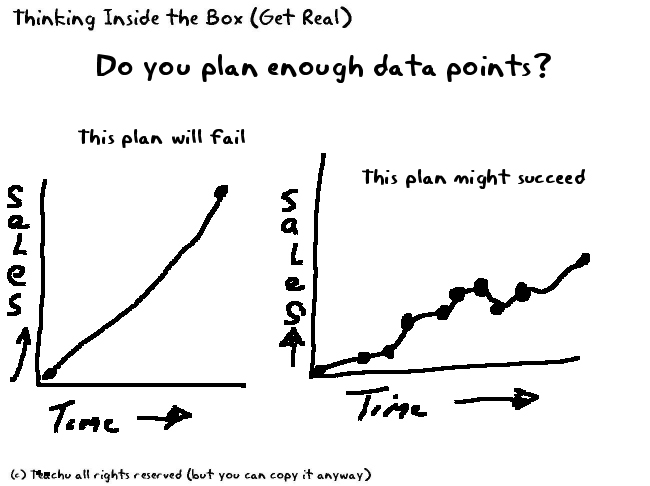Okay, first take a look at the napkin art. Then read the thinking below.

He needed me to:
1. Make a business plan
2. Raise money
3. Set up a website
4. Do all the marketing
5. Set up sales procedures
6. Organize the accounting
He did not plan to pay me a fee. He generously offered a percentage of his profits. I declined the offer. He will fail.
I’ve seen a lot of these “great idea” ventures fail. The person with the great idea usually bases their entire “rough” business plan on two data points. They start the business (Point A) and get rich (Point B).
One guy told me about how he was going to get rich selling pieces of wood for reptile cages. “People will pay a lot of money for a nice piece of wood and I have a huge supply of it for free. All I have to do is clean it up. I expect to make $100,000 in a month selling mail order to pet shops all over the country.” I asked him if he had visited the pet shops in his area to see if he could get some sales locally before sinking money in a brochure and mail costs. “No need. It’s a guaranteed winner.” Any guesses on how that story came out?
Big businesses do the same thing. They forecast a year ahead. Then, they adjust the forecast with each quarterly report. Most forecasting is a waste of time.
Planning is good. Plans should include scenarios for differing outcomes. Have you ever seen that? That’s because it’s never done, except by the military.
I think all businesses need to start doing their planning differently.
First, more data points. Don’t plan a quarter—look at months or weeks. You might have to look at days. The key is to set short, and I mean short, range goals. What can we do this week to stay on target? What can we do today to improve sales by 1%?
Forecasting too far out causes us to make big, foolish mistakes. If we are going to grow by 20% this year, what must we do? Something BIG.
But what if we want to improve margins by 1% this week? Increase sales by 2% this week? That’s easy. This is why I always look for small improvements that aggregate to big results. It’s cheaper and easier than risking all on the big play.
Next, I’d like to see planned scenarios. If sales increase by 15% over 6 months, we’ll do this. If margins fall by 5% we’ll do this. If margins increase by 5%, we’ll do this.
What invariably happens is that once the forecast is not met, all decisions become reactionary rather than planned.
Summary.
Do two things differently because we are in a faster paced economy.
1. Plan more data points.
2. Plan scenarios.
We need to get away from this notion that once we submit the plan for the year, we follow it…unless things go bad. Then we cut, cut, cut. If things go well, we coast.
Can you imagine what could happen at GM if they took suggestions from all their employees all the time—what could we do tomorrow to sell 1% more cars? What could we do to improve mileage by 1%? The aggregated improvements over a year would bring the phoenix from the ashes.
Chris Reich, Author of TeachU’s Business Talk Blog
Chris@TeachU.com
